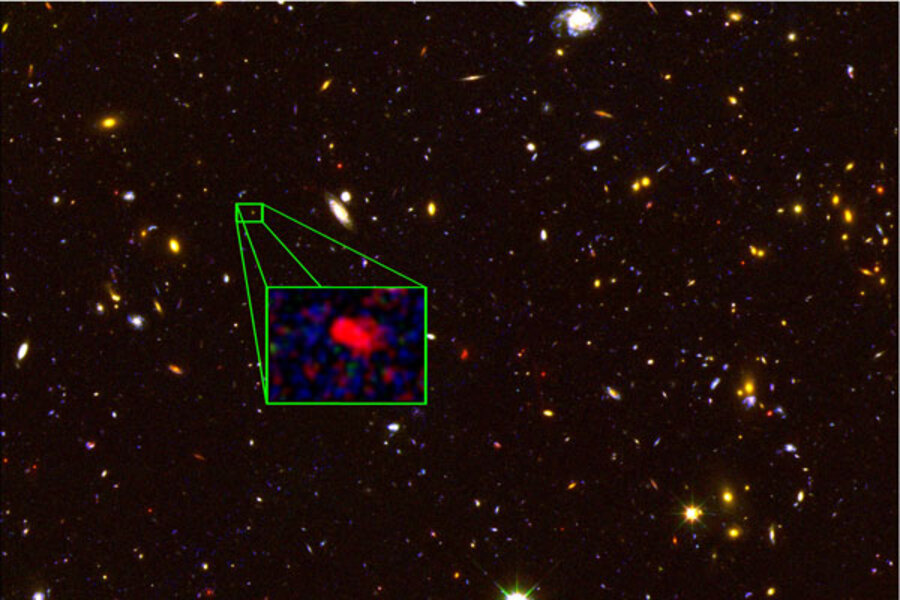Most-distant galaxy ever found a glimpse into universe's mysterious dark ages
Loading...
Astronomers have uncovered the most-distant galaxy yet confirmed – an object hinting that the early universe may have formed more stars and displayed more chemical complexity than researchers previously believed.
In addition, the researchers may have caught the galaxy in the act of helping to burn off a dense fog of molecular hydrogen between galaxies, lifting the universe out of a period known as the cosmic dark ages. This period lasted about 170 million years, during which the fog prevented light from traveling from one galaxy to another.
The galaxy, labeled z8_GND_5296, appears some 13.1 billion light-years away in the northern sky. Its distance corresponds to a time when the universe was only 700 million years old.
Several dozen galaxies have been spotted at this or greater distances, the researchers acknowledge. But only five others have had their distances confirmed using a key spectral marker. All five are slightly closer than the new galaxy, described by a team led by University of Texas astronomer Steven Finkelstein. A formal report on the team's observations are set to appear in Thursday's issue of the journal Nature.
The researchers observed the galaxy when it was perhaps 10 million to 15 million years old. The galactic infant was puny by today's standards; it sported only 0.1 percent of the Milky Way's considerable mass.
At the time, however, it was forming stars at a furious pace – the equivalent of some 330 suns a year, by mass, compared with 1 to 7 solar masses a year in the Milky Way today. The rate is so high that the researchers estimate if that rate had been consistent through that point in the galaxy's evolution, the total mass of all its stars would double at least once every 4 million years.
The galaxy is also chemically rich for its age, Dr. Finkelstein adds.
Chemical elements heavier than hydrogen form in stars. The earliest stars were thought to be enormous. They burned fast and furious. Finally, after several million years, they exhausted their hydrogen fuel and exploded, hurling their outer layers into space. Each succeeding layer is dominated by elements heavier that those in the preceding layer, up to iron. These elements enrich clouds of dust and gas between stars, clouds that eventually will collapse to form a new generation of stars.
Using the chemical composition of the sun as a baseline, the galaxies in the nearby universe host a similar abundance of these heavier elements, which astronomers lump together as “metals.”
The galaxy Finkelstein and his colleagues describe has about 20 to 40 percent of the sun's metal content, which suggests a richer variety of chemical elements than previously thought – elements necessary to form the raw materials for planets and eventually people.
The galaxy was one of 43 in the team's survey, and the process of finding it could shed light on the period when the early universe was still enveloped in hydrogen fog. Indeed, z8_GND_5296 was the only one of the 43 galaxies for which the researchers detected a prominent feature known as the Lyman-alpha line, which is part of the hydrogen spectrum.
Why didn't they see it in the other galaxies?
For one, the line is hard to detect in early galaxies. While its signature sits squarely in the ultraviolet portion of the electromagnetic spectrum, meaning it has a relatively short wavelength, the ongoing expansion of the universe since the big bang stretches that light to longer wavelengths with distance.
From Earth's vantage point, the Lyman-alpha line from z8_GND_5296 has been stretched so far that it can be seen only at long near-infrared and infrared wavelengths.
“We couldn't even see these galaxies until Hubble got the near-infrared camera installed” during NASA's final Hubble servicing mission in 2009, Finkelstein says. The team then aimed the 10-meter Keck 1 telescope top Hawaii's Mauna Kea at the galaxy for more detailed observations.
But other factors could be at play, too. Astronomers can detect the line for some 60 to 80 percent of the galaxies that show up 300 million years later than z8_GND_5296. As astronomers look farther back, however, that figure drops to between 10 and 20 percent.
“We realized we could learn something from that,” Finkelstein says.
The lack of lines in the other galaxies could suggest that they were filled with their own molecular-hydrogen fog. If that's true, it would suggest that such early galaxies could accrete gas at unexpectedly high rates, the team suggests. The data could also suggest that z8_GND_5296 was one of the early galaxies responsible for burning off the hydrogen fog, thanks to the intense radiation produced by its high rate of star formation.
This burning-off process, known as cosmic re-ionization, ultimately led to a transparent universe, allowing light to traverse the cosmos. Re-ionization is thought to have lasted several hundred million years, “but we don't know exactly when it ended, and we can't yet account for all of the galaxies that did it,” Finkelstein says.
The data showing a gradual increase in Lyman-alpha detection as the universe aged could point to this vital period in the universe's evolution.
That interpretation, he says, “is consistent with the signature we're seeing.”







